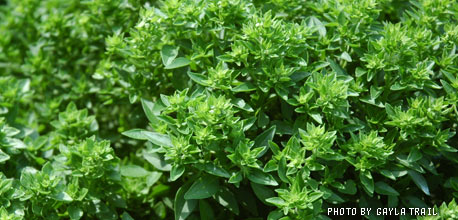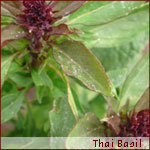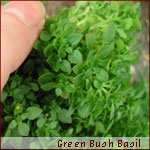 Guest post by Kelly Gilliam
Guest post by Kelly Gilliam
What do you think of when you imagine basil? The scent of a summer herb garden filling your nostrils? The taste of a nice pesto on a cool evening? Bees rushing around feverishly from tiny flower to tiny flower? Or maybe it’s just the different textures, sizes, shapes and tastes that spring to your mind when you ponder the dozens of available varieties of basil-and there are dozens to say the least. The ever-popular sweet basil (Ocimum basilicum) is the most commonly seen in kitchen gardens and windowsills alike. However, it is limiting to restrict yourself to only this kind of basil. Each variety can uniquely enrich not only the flavour of your cooking, but also the look of your garden.
Despite their variations in flavour and appearance, the different types of basil are similarly easy to care for. Being a plant of tropical Asian descent, basil likes well-drained soil and plenty of light, ideally bright direct afternoon sun. One thing that my years of raising basil have taught me is that the plant must not be waterlogged; allowing the soil to dry out between waterings helps greatly. I have also found it easier to grow basil in a container than in the ground. Moisture levels can be more easily monitored in a container, and if the initial location is not immediately beneficial, the plant can easily be moved to another spot. For containers, I always pick something shallow, like a pot made for bulbs or succulents. Basil has shallow roots and placing it in a more shallow pot allows the roots to reach out in a more natural manner and also to stay warm, something which is essential for basil to grow strong and healthy.
Thousands of years ago, basil was the subject of much debate in the realm of herbal medicine. While some embraced the herb as not only a wonderful source of flavour but also of relief for digestive ailments, other ancient herbalists claimed that basil damaged internal organs and caused insanity, coma, and the spontaneous generation of assorted detrimental parasites and arachnids, such as lice and scorpions! However, the Roman naturalist Pliny himself was a proponent of the good that basil exacted upon the human body and was the first to suggest that it alleviates flatulence, something which modern pharmacology supports. Basil has also been shown to relieve nausea and stomach upset when administered as a tea, much like its mint cousins.
Following are eight common varieties of basil that are relatively easy to find and should be in stock in your local nursery in the spring. Of course this is only a small sampling of the dozens of varieties available. My best suggestion would be to get as many varieties as you can and experiment with the different flavours by adding the fresh leaves to your cooking. After all, when you cook with herbs you’ve raised yourself, it always gives you a new appreciation of your food. Remember to go herb shopping early to get the best selection.
Sweet Basil (Ocimum basilicum)
Sweet basil is easily the variety most frequently seen in herb (or any) gardens. It has a strong, almost tart flavour when fresh, but when dried, its flavour sweetens. This particular variety has a mild initial taste which lasts on the tip of the tongue. The aftertaste is strong and lingers in the back of the throat, almost leaving a sensation in your nose.
African Blue Basil (Ocimum kilimanscharium x Ocimum basilicum purpurescens)
This is a personal favourite of mine. The fresh leaves have a strong initial flavour, which is much sweeter than sweet basil. Not only is the flavour more enjoyable, but it also has gorgeous green foliage streaked with purple veins, and deep purple flower heads. Its texture is also a surprise to most people who are used to sweet basil. While most basils have a very smooth leaf, African blue basil is fuzzy and almost rough, something you can also taste when it is added to a dish. It does not have an overpowering aftertaste, and does not linger in the back of the mouth as sweet basil does. As if these factors were not enough to ensure a permanent spot in my favourite basil list, African blue basil is also very easy to grow, and sends out new shoots incredibly quickly.
 Lemon Basil (Ocimum americanum)
Lemon Basil (Ocimum americanum)
This basil is true to its name-one sniff and one would swear one was in a lemon orchard. Initially, it tastes almost the same as most basils, but its slight aftertaste resembles that of lemon balm. It has a very mild flavour, and while it smells beautiful, the ‘lemon’ in the name does trick one into expecting something that tastes a little more lemony. That aside, it is a nice addition to the garden, and a nice addition to a recipe that may call for citrus highlights. I have had more trouble growing this basil than any other. I had two plants, one which received sun for about seven hours a day, and another which received sun for about three hours. Both were leggy despite being pinched back, and were very slow growing despite optimum soil and water.
 Thai Basil (Ocimum basilicum ‘Thai’)
Thai Basil (Ocimum basilicum ‘Thai’)
As the name might suggest, this variety had a very spicy flavour with a slight hint of licorice, but with a nice mild aftertaste. Along with the African blue basil I found this one very fast and easy to grow, and also quite pleasing to the eye. It produced flower heads that were deep burgundy, which contrasted nicely against this variety’s pale green leaves. This is also a favourite of mine, and goes well in any dish with heavy spices. This is the herb for all your authentic Thai curries!
 Cinnamon Basil (Ocimum basilicum ‘Cinnamon’)
Cinnamon Basil (Ocimum basilicum ‘Cinnamon’)
This variety is very true to its name, and had a distinct cinnamon aftertaste. Although initially it very much resembles the tartness of sweet basil, it has a cool flavour that would probably be excellent for a cold dish that called for the addition of basil.
Spicy Globe Basil (Ocimum basilicum ‘Minimum’)
This basil is actually milder than the variety name would have you believe. While it is excellent for a container or smaller spaces because of its tiny leaves (measuring 1-1½ cm long) and compact growth habit, its flavour very closely resembles that of sweet basil. It does have a slight sage flavour, and would probably be excellent in complimenting sage in a dish.
Rubin Basil (Ocimum basilicum ‘Purpurascens’)
Also known as Dark Opal Basil. It has dark purple/reddish foliage which adds a sharp contrast to any herb garden. It has a strong dry bite with a taste that lingers on the tongue and leaves your mouth feeling parched. While it is a good strong basil, which I’m sure some must love, I found myself valuing it more for its dark purple leaves instead of its rather acerbic taste.
 Green Bush Basil (unknown, might be another variety of O. basilicum ‘Minimum’)
Green Bush Basil (unknown, might be another variety of O. basilicum ‘Minimum’)
This is another variety of basil excellent for growing in containers. It is small, and has much the same growth habit as spicy globe basil. However, instead of dark purple its flower heads are straight green like the rest of the plant. Also unlike spicy globe basil, it has more of an actual spiced flavour. It has a delicious aftertaste, which stays strong but does not overwhelm the senses like some basils have a tendency to do.
Baked Lemon Basil Chicken
Ingredients:
2 pieces of boneless & skinless chicken breast
1 good handful of lemon basil
3 sprigs of African blue basil
½ cup of water
¼ cup of olive oil
1 sprig of rosemary
1 sprig of tri-colour sage
1 tsp lemon juice
dash of pepper
1. Combine all herbs, oil, water, pepper & lemon juice in blender and liquefy.
2. Place defrosted chicken breast in marinade in a sealable container and place in the fridge over night.
3. When you are ready to prepare dinner, take out the chicken breast and place it in a baking pan that is lightly coated with olive oil.
4. Preheat oven to 375 degrees.
5. Take the rest of the marinade and paint it onto the breasts. Place chicken in the oven with the cover on for 30-45 minutes or untilgolden brown. For extra flavour, add a thin slice or two of lemon to the top of the chicken while baking.
Serves 2
Herb & Veggie Fried Rice
Ingredients:
1 cup of rice
½ yellow pepper
2 tbsp of onion
1 tbsp of sunflower oil
3 large mushrooms
One sprig of fresh rosemary
One sprig of fresh thai basil
6-7 leaves of fresh sage
1. Pick your favourite kind of rice and prepare.
2. Once the rice is cooked, take out a fry pan and coat with the sunflower oil. Place rice in the pan and start to cook over low-medium heat.
3. Chop onions, pepper, mushrooms, rosemary, sage and basil and add to rice. Cook until rice is slightly browned and flavours have infused. Peppers, onions and mushrooms should be tender.
4. This can be used as a meal or as a side dish.
Makes 3-4 servings.
Bibliography
Claire Kowalchik and William H. Hylton, ed. Rodale’s Illustrated Encyclopedia of Herbs. Pennsylvania: Rodal Press, 1998.
Inge N. Dobelis ed. Magic and Medicine of Plants. New York: The Reader’s Digest Association, Inc., 1989.
Kelly Gilliam is a full-time greenhouse employee from the Greater Vancouver, B.C. area gardening out of primarily containers due to her urban enclosure. Because of her discount at work she is utterly hopeless about bringing home plants, doing it on a weekly basis. Her favourites are any kinds of cacti and succulents, which she also obsessively cultivates from seed. When she’s not at work or puttering around the local second-hand shops for interesting junk she runs Devileye.net.